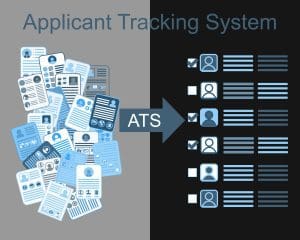Job seekers need to ensure their resumes are optimized for ATS. This means using relevant keywords, keeping the format clean, and avoiding complicated designs. Understanding common industry terms improves visibility, and a simple layout makes it easier for the ATS to read the resume. By implementing these strategies, candidates can increase their chances of completing the ATS gauntlet and securing interviews.
Key Takeaways
- Resumes should be optimized for today’s Application Tracking Systems (ATS).
-
Job seekers must be familiar with applicant tracking systems, as employers often use these tools to filter resumes.
-
ATS can streamline the hiring process. They also have downsides, as they could pass over qualified candidates due to formatting problems.
-
Adapt your resume using keywords and phrases that align with the job description. This will help you pass through ATS filters more effectively.
-
Keep your resume’s formatting simple and straightforward, without any fancy designs that can confuse ATS software.
-
Tackle widespread ATS myths, like the idea that all recruitment automation solutions are identical; knowing how different systems work can help tailor your application strategy.
-
Stay on the pulse of the latest in applicant tracking systems. This knowledge will enable you to adapt your job search techniques and remain competitive in the job market.
Since their appearance in the late ’90s, applicant tracking systems (ATS) have changed the game regarding hiring, these software tools filter resumes to help employers manage the overwhelming number of applications they receive by looking for keywords and formatting.
Are you challenged trying to optimize your resume for ATS success? You are not alone! Look no further! Let Deb Oronzio take the guesswork out of this challenge for you. With her expertise and special offer, you can sit back and relax while she works her magic on your resume. Don’t waste more time trying to figure it out alone – let Deb make your resume shine!
 What Are Applicant Tracking Systems
What Are Applicant Tracking Systems
1. Definition of ATS
Applicant Tracking Systems (ATS) streamline the entire hiring process by automating candidate screening, significantly boosting recruitment efficiency. These advanced ATS enable employers to filter resumes based on job descriptions, ensuring that the right resumes are highlighted. However, there is a potential for bias in ATS algorithms, which can unintentionally affect the selection of diverse candidates. Additionally, ATS enhances communication between recruiters and candidates, keeping both parties informed throughout the recruitment lifecycle.
2. Purpose of Using ATS
The main reason to use an applicant tracking system (ATS) is to save time for busy recruiters managing numerous job applications. According to the data, sourcing for one job takes about 13 hours on average. An ATS automates tasks such as tracking candidate stages and maintaining structured workflows, ensuring your hiring process remains efficient in fast-paced environments. These systems also provide detailed analytics on recruitment efforts, enhancing future recruiting strategies. Importantly, over 95% of Fortune 500 companies currently utilize ATS solutions to streamline their applicant tracking processes.
3. Mechanics of ATS Operation
ATS has plenty of advantages, but it also presents its own challenges, particularly regarding applicant tracking systems. Strict filtering criteria can lead the system to overlook qualified applicants who possess useful skills despite not being the perfect fit for your stated requirements. This issue is especially problematic for applicants whose resumes aren’t ATS-compliant, as they won’t be detected during the ATS scan, even if they are highly qualified. Additionally, technical issues can hinder the use of the application, creating further barriers for both employers and candidates. A robust ATS should address these concerns while ensuring a smooth recruitment process throughout the hiring process.
Benefits and Drawbacks of ATS
Advantages of Using ATS
What are the benefits of using an applicant tracking system (ATS) for both employers and job seekers? By writing their resumes with ATS in mind, candidates can significantly improve their chances of clearing the initial filters during the job application process. Understanding how to optimize their documents is essential. A simple solution, such as using a single-column format, allows the ATS to parse the text effectively. Presenting work history chronologically aligns with ATS expectations, making it easier for recruiters to assess qualifications quickly.
Job seekers should use simple designs or graphics to maximize visibility and enhance their chances in the competitive job market, as these can confuse ATS scanners. By adhering to these formatting guidelines, candidates can present their qualifications clearly and effectively, streamlining the entire hiring process. This structured approach benefits job candidates and appeals to companies seeking top talent through efficient recruitment tools.
Limitations of ATS
An ATS, or applicant tracking system, poses certain drawbacks that candidates must navigate carefully. One important aspect is to look at job postings for relevant keywords. When these terms are incorporated into an ATS resume, they can significantly enhance hiring managers’ visibility. Hard and soft skills are essential in job descriptions, demonstrating that you are a well-rounded candidate.
Top ATS services will strategically position these keywords throughout the resume to optimize ATS screening performance. Ensure that keywords are naturally woven into your experiences and accomplishments rather than forced in. Balancing optimization with readability is crucial, ensuring your resume appeals to both ATS tools and human recruiters alike, ultimately improving your chances in the competitive job application landscape.
Optimizing Resumes for ATS
1. Writing an ATS-Compatible Resume
To make your resume ATS-friendly, it’s crucial to clearly label sections and keep them simple (i.e., just “Work Experience” and “Skills”) so your applicant tracking system can read them easily. Place your address on your resume at the top of the document for easy visibility. Organizing content logically—starting with your summary, followed by experience, skills, and education—enhances ATS scanning and overall recruitment efficiency during the hiring process.
2. Enhancing Resumes with Keywords
Avoid using images or graphics in your resume, which can confuse applicant tracking systems (ATS). Visual elements disrupt the parsing process, leading to potential oversights of your qualifications or misinterpreting your skills. Instead, maintain a text-based resume and incorporate specific keywords that align with top ATS requirements to enhance your job applications.
3. Choosing the Right File Format
When saving your resume for job applications, utilize PDF or .docx format, as these are widely accepted by most applicant tracking systems (ATS). This ensures your resume is easily readable by the ATS tool, so choose standard fonts like Arial or Times New Roman, sized between 10 and 12 points. Additionally, incorporate clear headings and subheadings to enhance the ATS scanning process and improve your chances of standing out in the recruitment landscape.
4. Placing Key Information Correctly
Craft a concise resume headline that clearly indicates your target job, as this enhances your chances during the ATS scan. By incorporating relevant keywords into this title and positioning it at the top of your resume, you ensure it efficiently captures the attention of recruiters sorting through numerous job applications.
5. Avoiding Images and Graphics
Remember to use bullet points in your ATS resume to make it easy for applicant tracking systems to see your accomplishments and duties. Keep bullet points short, emphasizing measurable outcomes demonstrating your contribution in past positions while ensuring your formatting is consistent for a clean, professional presentation.
Let Deb Oronzio take the guesswork out of it for you. With her expertise and special offer, you can sit back and relax while she works her magic on your resume. Don’t waste more time trying to figure it out alone – let Deb make your resume shine!
Formatting Tips for ATS Compatibility
Adding a Clear Resume Title
Using a clear resume title will help Applicant Tracking Systems (ATS) more easily parse your information, making your job application stand out in the recruitment process. Candidates should utilize a simple line-by-line format; complex resume designs with multi-columns or tables can confuse ATS software and misinterpret qualifications. Experiment with various resume formats to determine the most effective layout for your resume, ensuring it flows well for optimal ATS scanning.
Using Straightforward Bullet Points
When writing a bullet point, don’t overthink it. To check ATS compatibility with your resume, candidates can convert their documents to plain text, ensuring they meet necessary ATS requirements. This process helps catch any formatting issues that could hinder ATS scanning. Reviewing the plain text version allows both the applicant tracking system and human recruiters to easily assess your qualifications and strengthen your job application.
Maintaining a Simple Resume Layout
One of the biggest misconceptions about applicant tracking systems (ATS) is that they only favor certain educational backgrounds or experiences. In fact, modern ATS tools can be set up to identify a far broader array of qualifications and skills, enhancing the recruitment process. It’s also worth noting that not all resumes uploaded to an ATS scan are automatically weeded out. Knowing this can alleviate some job application anxiety and encourage candidates to share their diverse experiences.
Creating an ATS-Friendly Format
While some may feel that an applicant tracking system (ATS) is infallible in evaluating candidate qualifications, it is essential to understand its limitations. ATS relies on algorithms that can sometimes misinterpret resume content, potentially overlooking qualified candidates. Despite this technology, human recruiters still play a vital role in the entire hiring process. This dual approach underscores the need to create a strong resume that attracts both ATS tools and people.
Converting Resumes to Plain Text
Candidates must understand ATS resume functionality when applying for jobs. An applicant tracking system doesn’t just filter resumes—it also aids in resume tracking during the hiring process. This recruitment tool simplifies communication between recruiters and candidates while providing reporting features that offer insights into recruiting metrics. By leveraging these advanced applicant tracking systems, candidates can better position themselves in the competitive job market.
Common Misconceptions About ATS
Myths Surrounding ATS Functionality
Many things need to be clarified about how Applicant Tracking Systems (ATS) work in the recruitment landscape. Many job seekers think these systems automatically discard resumes, with some claiming that “robots” throw away as much as 75% of them. However, this claim is misleading. ATS does not automatically reject resumes; instead, it assists recruiters in filtering job applications based on the criteria set by hiring managers. Advanced applicant tracking systems that enhance recruitment workflows support this efficient hiring process.
Other myths include that only specific file formats (like .doc or plain text) are allowed. Most modern ATS can parse PDFs just fine. Over 100 ATS platforms exist today, all with different bells and whistles. It’s not accurate to say all these systems operate the same way. Only Taleo uses a rating system based on parsed resumes, demonstrating the variety between ATS technologies.
Clarifying ATS Capabilities
Understanding how applicant tracking systems (ATS) operate is crucial for both job seekers and recruiters. These robust ATS systems are essential to enhance the recruitment process’s efficiency. They help recruiters quickly sort through job applications, identifying candidates with specific qualifications. Since 2020, the ATS has been instrumental in collecting and assessing submissions, ensuring that resumes are not automatically rejected based on formatting alone.
The integration of AI in modern ATS tools could dramatically enhance candidate matching. By examining data trends, AI creates experiences that benefit both recruiters and job seekers, making the entire hiring process more effective and saving considerable time. Additionally, ongoing updates to ATS features are vital to adapt to evolving recruitment needs and preferences, ensuring that the system remains a top ATS choice for organizations.
Job seekers should avoid spending excessively on costly optimization services since it’s more effective to customize their resumes for specific roles. While such services can range from $100 to $500, they often must be revised for ATS compliance. Instead, investing time in tailoring job applications can yield significant rewards in the job candidate search.
Future of Applicant Tracking Systems
Prioritizing Candidate Experience
In 2024, applicant tracking system (ATS) providers will focus unprecedentedly on improving the candidate experience, recognizing its crucial role in overall recruitment efficiency. This change acknowledges the value of positive interactions throughout the hiring process, which can significantly enhance an organization’s reputation and attractiveness to top talent. Companies are increasingly investing in user-friendly ATS tools and simple application processes to create a more inclusive and welcoming experience for job seekers.
Embracing Diversity, Equity, and Inclusion
Modern ATS tools must evolve to uphold diversity, equity, and inclusion (DEI) principles to enable effective recruitment practices. This evolution is crucial for reinforcing a workplace culture that values diverse perspectives and experiences. More organizations will embrace ATS programs that promote unbiased hiring, ensuring that all job candidates receive equal consideration, regardless of their demographic traits.
Integration of Virtual and Augmented Reality
The idea of VR/AR integration into applicant tracking systems (ATS) is being explored, as these technologies promise to provide immersive candidate experiences. This innovation allows job seekers to interact with prospective employers uniquely, potentially transforming traditional interviews and onboarding processes into engaging experiences that effectively showcase company culture.
The Role of Artificial Intelligence
Artificial intelligence (AI) remains a game-changer in recruiting, particularly with advanced applicant tracking systems. About 60% of recruiters say they care about software with virtual onboarding capabilities, highlighting the importance of a robust ATS tool. This shift underscores the increasing need for intelligent solutions that enhance resume tracking, making it easier for new hires to ramp up while streamlining the entire hiring process through efficient candidate matching and predictive analytics.
Seamless Integration with HR Software
The future of ATS resume technology will feature greater integration with advanced applicant tracking systems (ATS) and other human resource management systems (HRMS). This unified approach builds a cohesive recruitment ecosystem, enhancing recruitment efficiency. Better sharing of candidate data and aligned processes drive tremendous organizational success, enabling strategic hiring decisions throughout the hiring process.
Conclusion
Working with Applicant Tracking Systems (ATS) can be a daunting task. Knowing how they work gives you a big leg up in your job search. Finally, tweak your resume so it shines. Debunk common myths to ensure your application stands out in the crowded digital space. Remember, it’s equally about what you say and how you say it. Formatting, using keywords, and all those things are crucial to get past those automated filters. Technology will always be changing. By keeping your finger on the pulse of what’s hot and what’s not, you can sift through the noise and find your voice in this crowded arena.
Get control of your job hunt now! Start sharpening your resume with these insights, and new opportunities will appear.
Frequently Asked Questions
What is an Applicant Tracking System (ATS)?
An ATS, a powerful applicant tracking system, assists employers in managing the recruitment process by reviewing resumes, extracting candidate information, and sorting job applications efficiently.
How does ATS benefit employers?
ATS automates resume sorting within the applicant tracking system to streamline hiring. This recruitment tool reduces time spent on manual reviews and enhances candidate matching based on job requirements.
Are there any drawbacks to using ATS?
Yes, applicant tracking systems (ATS) can inadvertently filter out qualified candidates due to strict keyword matching, impacting overall recruitment efficiency and making hiring less personalized.
How can I optimize my resume for ATS?
To improve your chances of passing the applicant tracking system (ATS) scan, use keywords from the job description, keep your resume straightforward, and incorporate one unique element to stand out.
What formatting tips should I follow for ATS compatibility?
Use common fonts, keep bullet points basic, and forego graphics or pictures. A clean layout makes it easy to read for both the applicant tracking system and human recruiters, ensuring your resume is ATS compliant.
What are common misconceptions about ATS?
It’s a common misconception that an applicant tracking system (ATS) only focuses on keywords. In fact, they also measure overall relevance and context, which is crucial for job applications. Knowing this can enhance your resume strategy.
What does the future hold for Applicant Tracking Systems?
The future of applicant tracking systems (ATS) is integrating AI to analyze candidates and enhance the user experience, ultimately streamlining the recruiting processes for more efficient and effective hiring.


0 Comments